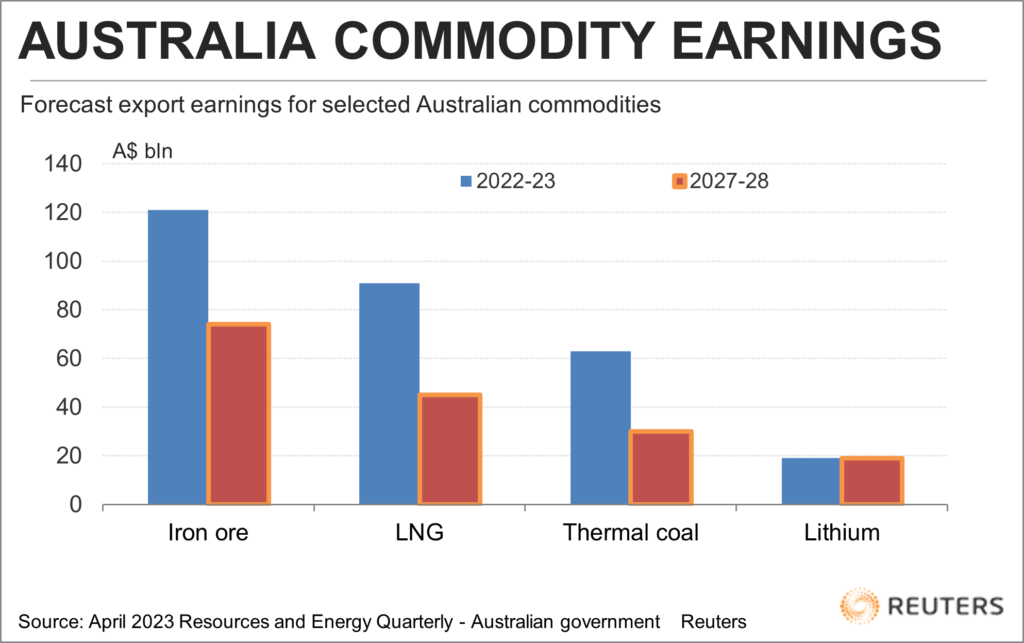
Leading commodity exporter Australia expects rising shipments of new energy metals in coming years, but in a blow to global climate change goals the government still forecasts steady volumes of fossil fuels such as coal and natural gas.
Earnings from natural resource exports will reach a record A$464.3 billion ($315.3 billion) in the 2022-23 fiscal year that ends on June 30, the Office of the Chief Economist in the Department of Industry, Science and Resources said in its latest quarterly report released on April 3.
This is up from the previous record of A$421.6 billion in the 2021-22 year, but the government’s commodity forecaster doesn’t expect the elevated earnings to persist as the impact of Russia’s invasion of Ukraine fades away.
Australia is the world’s largest exporter of iron ore, coking coal, liquefied natural gas (LNG) and lithium, while it ranks second in thermal coal and third in gold and in copper ores and concentrates.
By the 2027-28 fiscal year earnings from commodities will drop to A$335.9 billion, implying a compound annual decline of 3.7% from the current year.
The driving factor behind the lower earnings forecast is moderating prices, firstly as the world economy slows and secondly as more global supply is added in key commodities.
The government forecaster does expect Australia to export rising volumes of new energy metals, including lithium, nickel, copper and zinc.
But it also expects the prices for most of these metals to decline over the forecast period.
Lithium export volumes are expected to rise to 4,462 tonnes by 2027-28 from 3,080 in 2022-23, but the price is slated to fall to $2,700 a tonne from $4,104 in the current fiscal year.
Nickel exports are expected to lift to 215,000 tonnes by 2027-28 from 164,000 in the current year, but the price will drop to $21,313 a tonne from $24,414.
Copper shipments will rise to 970,000 tonnes in 2027-28 from 873,000 this year, and the price will defy the declining trend, rising to $9,954 a tonne from the current year’s $8,406.

While the report shows that Australia will produce more of the materials needed for the energy transition, it also shows that the country will still export large volumes of fossil fuels, even if the expected prices for the polluting fuels are expected to drop sharply.
Exports of thermal coal, used to generate power, are expected at 195 million tonnes in 2027-28, up from 182 million in the current year, although the price is forecast to slide to $103 a tonne from $313.
Coking coal shipments are expected to rise to 172 million tonnes from 164 million, although the price is forecast to drop to $185 a tonne from $296.
Exports of liquefied natural gas (LNG) are expected to remain largely steady with the 80 million tonnes in 2027-28 being little changed from the 82 million in 2022-23.
However, the price is expected to drop to A$13 a gigajoule from A$21 in the current fiscal year.
Australia’s most valuable commodity export, iron ore, is also not spared expectations of lower prices, with a forecast for $69 a tonne in 2027-28 being down from the current $97.
Iron ore export volumes are tipped to rise to 989 million tonnes by 2027-28 from the 887 million forecast for 2022-23.
Overall, the Australian government is painting a strong outlook for commodity export volumes, but a soft outcome for prices, even for the energy transition metals.
While proponents of the energy transition will be heartened by the rising investment and volumes in metals such as lithium, the expectation that fossil fuel exports will remain around current levels over the next five years will be disappointing.
(The opinions expressed here are those of the author, Clyde Russell, a columnist for Reuters.)
(Editing by Sonali Paul)
Comments